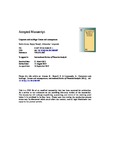Rating or no rating? That is the question: an empirical examination of UK companies
| dc.contributor.author | Paul, S | |
| dc.contributor.author | Gonis, E | |
| dc.contributor.author | Tucker, J | |
| dc.date.accessioned | 2018-04-23T15:52:33Z | |
| dc.date.available | 2018-04-23T15:52:33Z | |
| dc.date.issued | 2012-09-01 | |
| dc.identifier.issn | 1351-847X | |
| dc.identifier.issn | 1466-4364 | |
| dc.identifier.uri | http://hdl.handle.net/10026.1/11330 | |
| dc.description.abstract |
The aim of this paper is to examine the main determinants of the rating likelihood of UK companies. We use a binary probit specification to model the main drivers of a firm's propensity to be rated. Using a sample of 245 non-financial UK companies over the period 1995-2006, representing up to 2872 firm years, the study establishes important differences in the financial profiles of rated and non-rated firms. The results of the rating likelihood models indicate that the decision to obtain a rating is driven by a company's financial risk, solvency, default risk, public debt issuance, R&D, and institutional ownership, thus identifying a wider range of determinants and extending the current literature. The study also finds that the rating decision can be modelled by means of a contemporaneous or predictive specification without any loss of efficiency or classification accuracy. This offers support to the argument that the rating process is fundamentally forward-looking. © 2012 Copyright Taylor and Francis Group, LLC. | |
| dc.format.extent | 709-735 | |
| dc.language | en | |
| dc.language.iso | en | |
| dc.publisher | Informa UK Limited | |
| dc.subject | 3801 Applied Economics | |
| dc.subject | 35 Commerce, Management, Tourism and Services | |
| dc.subject | 3501 Accounting, Auditing and Accountability | |
| dc.subject | 3502 Banking, Finance and Investment | |
| dc.subject | 38 Economics | |
| dc.subject | 3507 Strategy, Management and Organisational Behaviour | |
| dc.title | Rating or no rating? That is the question: an empirical examination of UK companies | |
| dc.type | journal-article | |
| dc.type | Article | |
| plymouth.issue | 8 | |
| plymouth.volume | 18 | |
| plymouth.publication-status | Published | |
| plymouth.journal | The European Journal of Finance | |
| dc.identifier.doi | 10.1080/1351847X.2011.649215 | |
| plymouth.organisational-group | /Plymouth | |
| plymouth.organisational-group | /Plymouth/Faculty of Arts, Humanities and Business | |
| plymouth.organisational-group | /Plymouth/Faculty of Arts, Humanities and Business/Plymouth Business School | |
| plymouth.organisational-group | /Plymouth/REF 2021 Researchers by UoA | |
| plymouth.organisational-group | /Plymouth/REF 2021 Researchers by UoA/UoA17 Business and Management Studies | |
| plymouth.organisational-group | /Plymouth/Users by role | |
| plymouth.organisational-group | /Plymouth/Users by role/Academics | |
| dc.identifier.eissn | 1466-4364 | |
| dc.rights.embargoperiod | Not known | |
| rioxxterms.versionofrecord | 10.1080/1351847X.2011.649215 | |
| rioxxterms.licenseref.uri | http://www.rioxx.net/licenses/all-rights-reserved | |
| rioxxterms.type | Journal Article/Review |


